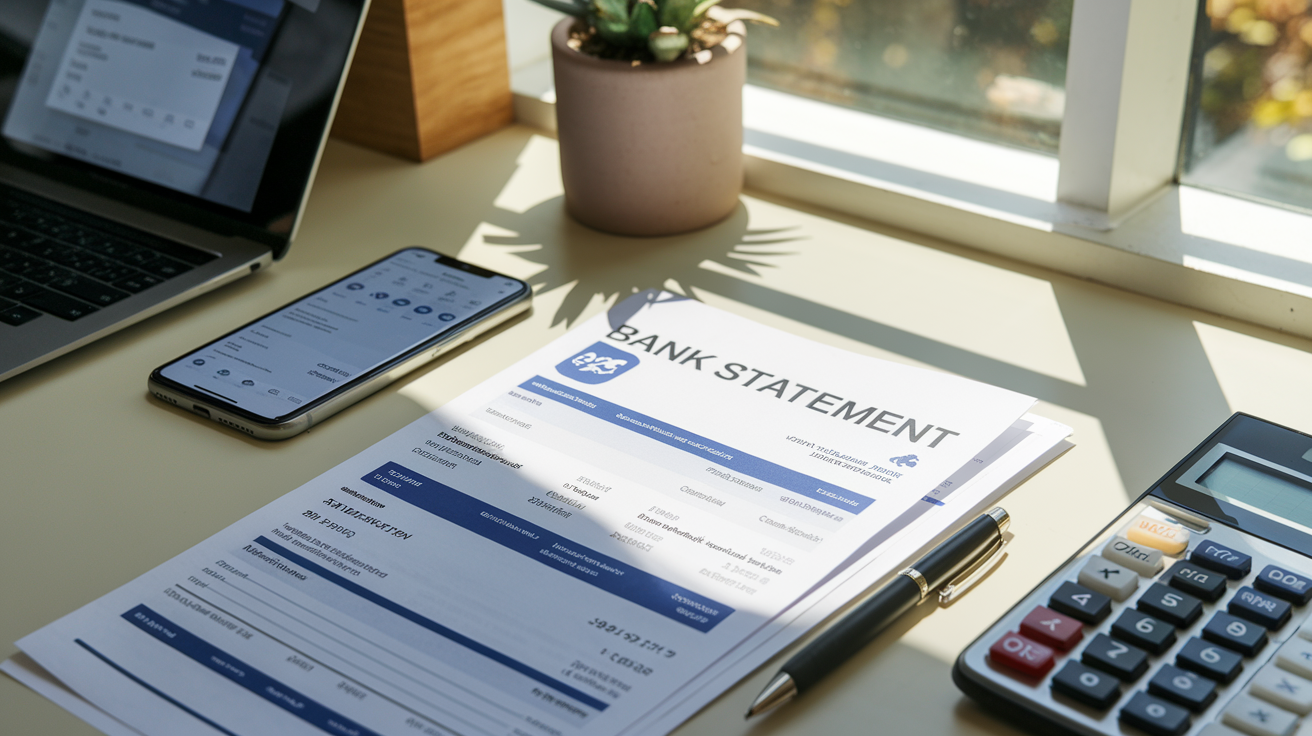Are you struggling to secure a second mortgage due to unconventional income sources? 🏠💰 Bank statement loans might be your golden ticket! These innovative lending options have become increasingly popular, especially for self-employed individuals and those with variable incomes.
But here’s the catch: navigating the world of bank statement loans can be tricky. Many borrowers find themselves overwhelmed by the documentation requirements and uncertain about how to present their financial situation in the best light. Don’t worry, though – we’ve got you covered! In this post, we’ll walk you through 4 game-changing tips that will help you easily secure a bank statement loan for your second mortgage. From understanding the basics to boosting your approval chances, we’ll cover everything you need to know to make your dream of homeownership a reality. Let’s dive in and explore how you can master the art of bank statement loans!
If you are in need of an urgent Bank Statement Loan for 2nd Mortgage with no proof of income for it verification purposes just google search ‘”Proofofstatement software‘” to generate a Customised proof of income documents instantly that will match the request for your loan approval. LEARN MORE.
Understanding Bank Statement Loans

Definition and purpose
A bank statement loan, also known as a non-QM (non-qualified mortgage) loan, is an alternative mortgage option designed for self-employed individuals or those with non-traditional income sources. The primary purpose of this loan is to provide financing options for borrowers who may not qualify for conventional mortgages due to their unique financial situations.
How they differ from traditional mortgages
Bank statement loans differ from traditional mortgages in several key aspects:
| Aspect | Traditional Mortgage | Bank Statement Loan |
|---|---|---|
| Income Verification | Tax returns, W-2s, pay stubs | Bank statements (12-24 months) |
| Employment Requirements | Steady, verifiable income | Flexible, suitable for self-employed |
| Debt-to-Income Ratio | Stricter limits | More lenient |
| Interest Rates | Generally lower | Typically higher |
| Loan Approval Process | Standardized | More individualized |
Advantages for second mortgage applicants
Bank statement loans offer several advantages for those seeking a second mortgage:
-
Flexible income verification: Ideal for self-employed individuals or those with irregular income streams
-
Faster approval process: Less documentation required compared to traditional mortgages
-
Higher loan amounts: Potentially qualify for larger loans based on cash flow
-
Debt consolidation: Use home equity to consolidate high-interest debts
-
Home improvements: Finance renovations or upgrades to increase property value
These loans provide an alternative path to homeownership or accessing home equity for borrowers who may not fit the conventional lending criteria. By focusing on cash flow rather than tax returns, bank statement loans offer a viable solution for many second mortgage applicants.
Prepare Your Financial Documents

A. Gather recent bank statements
To kickstart your bank statement loan application for a second mortgage, you’ll need to gather your most recent bank statements. Typically, lenders require the last 12 to 24 months of statements. Ensure you have complete statements for all your accounts, including:
-
Personal checking accounts
-
Savings accounts
-
Business accounts (if self-employed)
| Account Type | Number of Months Required |
|---|---|
| Personal | 12-24 months |
| Business | 12-24 months |
| Savings | 12-24 months |
B. Organize income and expense records
Next, create a clear picture of your financial health by organizing your income and expense records. This step is crucial for self-employed individuals or those with variable income. Consider the following:
-
Categorize income sources
-
Track business expenses
-
Separate personal and business transactions
-
Document any large deposits or withdrawals
C. Calculate your debt-to-income ratio
Your debt-to-income (DTI) ratio is a key factor in qualifying for a bank statement loan. To calculate your DTI:
-
Sum up your monthly debts
-
Divide by your gross monthly income
-
Multiply by 100 to get the percentage
Aim for a DTI below 43% to improve your chances of approval.
D. Compile asset information
Lastly, gather information about your assets. This can strengthen your application by demonstrating financial stability. Include:
-
Investment accounts
-
Retirement savings
-
Real estate holdings
-
Other valuable assets
By meticulously preparing these financial documents, you’ll be well-positioned to apply for a bank statement loan for your second mortgage. This thorough preparation not only streamlines the application process but also increases your chances of approval.
Improve Your Bank Statement’s Appearance

Maintain a healthy account balance
Maintaining a healthy account balance is crucial when applying for a bank statement loan for a second mortgage. Lenders want to see that you have sufficient funds to cover your expenses and potential mortgage payments. Here are some tips to keep your balance in good shape:
-
Aim for a consistent minimum balance of at least 2-3 months’ worth of expenses
-
Avoid letting your account dip below 20% of your average monthly balance
-
Set up automatic transfers to a savings account to build a cushion
| Balance Threshold | Impact on Loan Approval |
|---|---|
| Below 20% of average | Negative |
| 20-50% of average | Neutral |
| Above 50% of average | Positive |
Minimize large cash deposits
Large cash deposits can raise red flags for lenders, as they may indicate unreported income or unstable financial situations. To improve your bank statement’s appearance:
-
Limit cash deposits to small, regular amounts
-
Use electronic transfers or direct deposits whenever possible
-
Keep detailed records of any necessary large cash deposits
Avoid overdrafts and NSF fees
Overdrafts and non-sufficient funds (NSF) fees can significantly harm your chances of approval. These issues suggest poor financial management and may make lenders hesitant. To avoid them:
-
Set up low balance alerts on your banking app
-
Maintain a buffer in your account for unexpected expenses
-
Consider overdraft protection, but use it sparingly
Demonstrate consistent income patterns
Lenders look for stability in your income. To showcase this:
-
Aim for regular deposits on consistent dates
-
If you’re self-employed, try to invoice clients on a regular schedule
-
Keep business and personal expenses separate to clearly show income
By following these tips, you’ll improve your bank statement’s appearance and increase your chances of approval for a bank statement loan for your second mortgage. Next, we’ll explore additional strategies to boost your overall approval odds.
Boost Your Chances of Approval

Choose the right lender
When seeking a bank statement loan for a second mortgage, selecting the right lender is crucial. Not all lenders offer this type of loan, and those who do may have varying requirements. Research and compare lenders specializing in non-QM loans or alternative mortgage options. Look for institutions with experience in dealing with self-employed borrowers or those seeking mortgage without tax returns.
| Lender Type | Pros | Cons |
|---|---|---|
| Traditional Banks | Lower interest rates | Stricter requirements |
| Online Lenders | Faster approval process | Higher interest rates |
| Specialty Lenders | More flexible terms | May have higher fees |
Strengthen your credit score
A strong credit score can significantly improve your chances of approval for a bank statement loan. Take steps to boost your credit:
-
Pay all bills on time
-
Reduce credit card balances
-
Avoid applying for new credit
-
Dispute any errors on your credit report
Offer a larger down payment
Providing a substantial down payment demonstrates financial stability and reduces the lender’s risk. This can make you a more attractive candidate for a bank statement loan. Consider offering 20% or more of the home’s value as a down payment to increase your approval odds.
Consider a co-signer
If you’re having difficulty qualifying on your own, adding a co-signer with a strong credit profile can enhance your application. However, ensure the co-signer understands their responsibilities and potential risks.
Be prepared to explain any irregularities
Lenders will scrutinize your bank statements closely. Be ready to provide explanations for any unusual deposits or withdrawals. Maintaining consistent income and avoiding large, unexplained transactions in the months leading up to your application can help streamline the approval process.
Now that you’re equipped with strategies to boost your approval chances, let’s explore some common pitfalls to avoid when applying for a bank statement loan.

Getting a bank statement loan for a second mortgage doesn’t have to be a daunting process. By understanding how these loans work, preparing your financial documents meticulously, improving the appearance of your bank statements, and taking steps to boost your chances of approval, you can navigate this process with confidence.
Remember, lenders are looking for borrowers who demonstrate financial stability and responsibility. By following these tips and presenting a strong, organized financial picture, you’ll be well-positioned to secure the bank statement loan you need for your second mortgage. Take the time to gather your documents, clean up your statements, and put your best financial foot forward. With careful preparation and a clear understanding of the process, you can increase your chances of successfully obtaining the loan you need to achieve your real estate goals.




